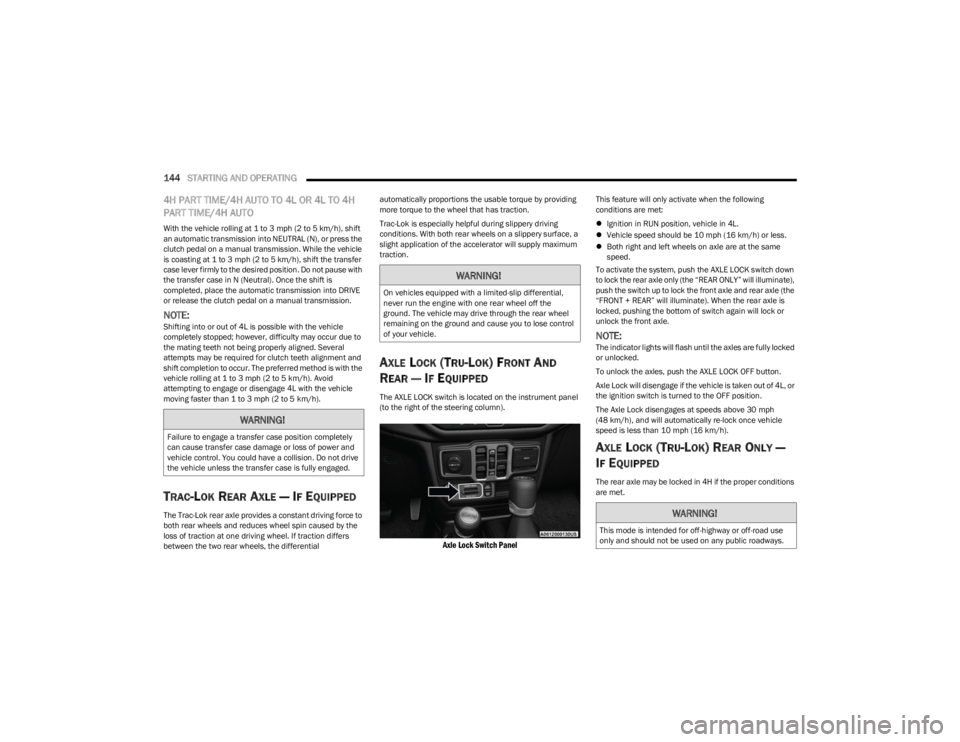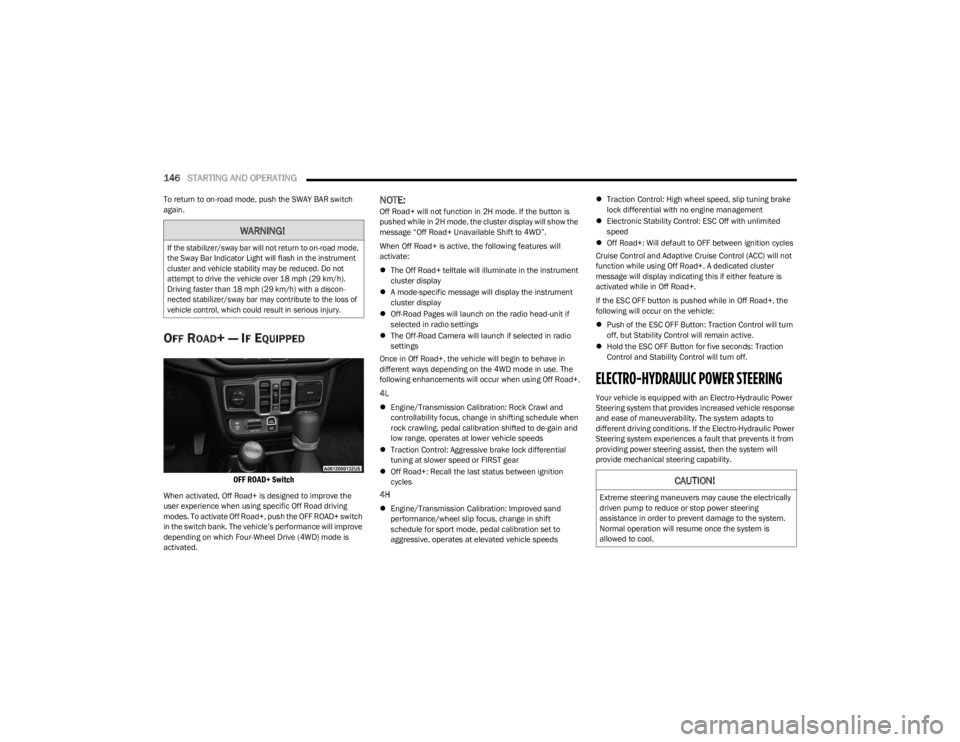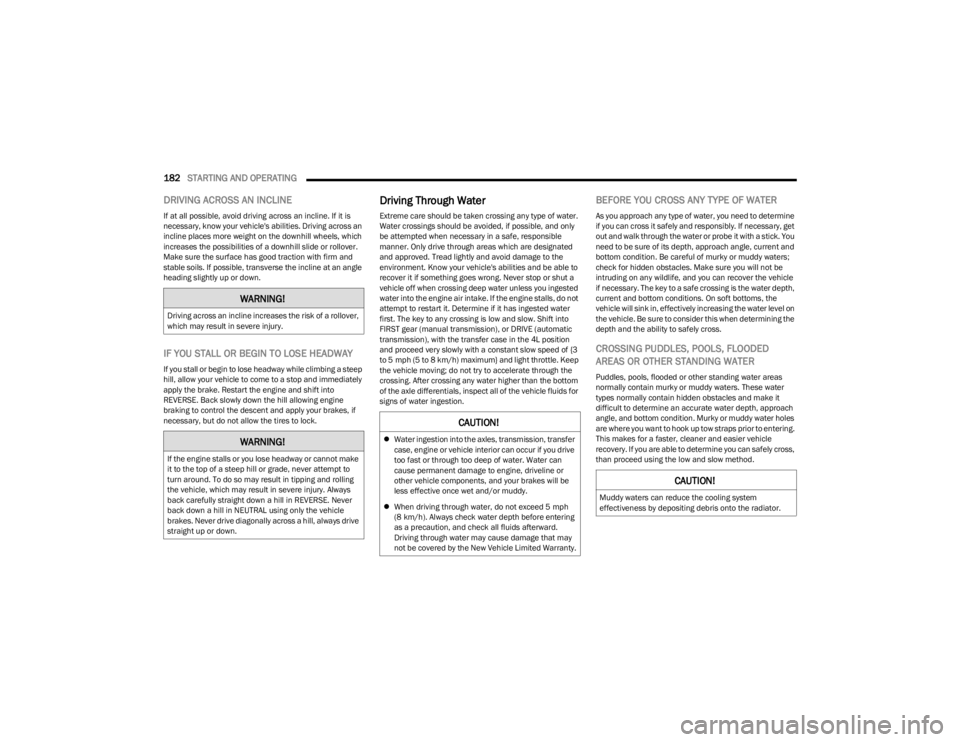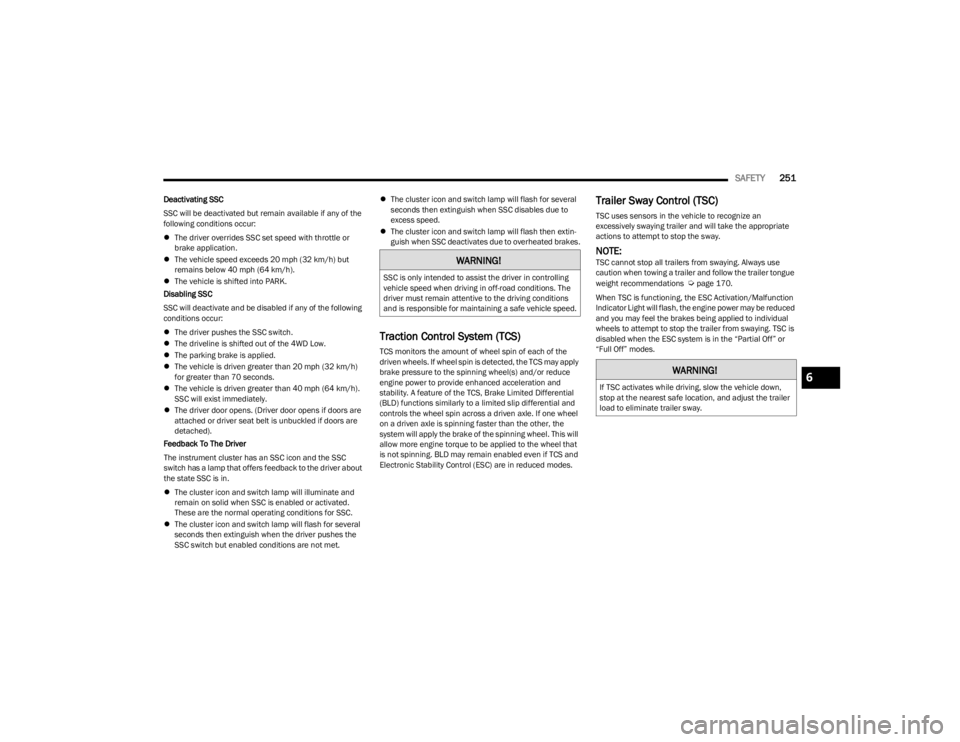differential JEEP WRANGLER 2023 Owners Manual
[x] Cancel search | Manufacturer: JEEP, Model Year: 2023, Model line: WRANGLER, Model: JEEP WRANGLER 2023Pages: 396, PDF Size: 25.15 MB
Page 146 of 396

144STARTING AND OPERATING
4H PART TIME/4H AUTO TO 4L OR 4L TO 4H
PART TIME/4H AUTO
With the vehicle rolling at 1 to 3 mph (2 to 5 km/h), shift
an automatic transmission into NEUTRAL (N), or press the
clutch pedal on a manual transmission. While the vehicle
is coasting at 1 to 3 mph (2 to 5 km/h), shift the transfer case lever firmly to the desired position. Do not pause with
the transfer case in N (Neutral). Once the shift is
completed, place the automatic transmission into DRIVE
or release the clutch pedal on a manual transmission.
NOTE:Shifting into or out of 4L is possible with the vehicle
completely stopped; however, difficulty may occur due to
the mating teeth not being properly aligned. Several
attempts may be required for clutch teeth alignment and
shift completion to occur. The preferred method is with the
vehicle rolling at 1 to 3 mph (2 to 5 km/h). Avoid attempting to engage or disengage 4L with the vehicle
moving faster than 1 to 3 mph (2 to 5 km/h).
TRAC-LOK REAR AXLE — IF EQUIPPED
The Trac-Lok rear axle provides a constant driving force to
both rear wheels and reduces wheel spin caused by the
loss of traction at one driving wheel. If traction differs
between the two rear wheels, the differential automatically proportions the usable torque by providing
more torque to the wheel that has traction.
Trac-Lok is especially helpful during slippery driving
conditions. With both rear wheels on a slippery surface, a
slight application of the accelerator will supply maximum
traction.
AXLE LOCK (TRU-LOK) FRONT AND
R
EAR — IF EQUIPPED
The AXLE LOCK switch is located on the instrument panel
(to the right of the steering column).
Axle Lock Switch Panel
This feature will only activate when the following
conditions are met:
Ignition in RUN position, vehicle in 4L.
Vehicle speed should be 10 mph (16 km/h) or less.
Both right and left wheels on axle are at the same
speed.
To activate the system, push the AXLE LOCK switch down
to lock the rear axle only (the “REAR ONLY” will illuminate),
push the switch up to lock the front axle and rear axle (the
“FRONT + REAR” will illuminate). When the rear axle is
locked, pushing the bottom of switch again will lock or
unlock the front axle.
NOTE:The indicator lights will flash until the axles are fully locked
or unlocked.
To unlock the axles, push the AXLE LOCK OFF button.
Axle Lock will disengage if the vehicle is taken out of 4L, or
the ignition switch is turned to the OFF position.
The Axle Lock disengages at speeds above 30 mph
(48 km/h), and will automatically re-lock once vehicle
speed is less than 10 mph (16 km/h).
AXLE LOCK (TRU-LOK) REAR ONLY —
I
F EQUIPPED
The rear axle may be locked in 4H if the proper conditions
are met.
WARNING!
Failure to engage a transfer case position completely
can cause transfer case damage or loss of power and
vehicle control. You could have a collision. Do not drive
the vehicle unless the transfer case is fully engaged.
WARNING!
On vehicles equipped with a limited-slip differential,
never run the engine with one rear wheel off the
ground. The vehicle may drive through the rear wheel
remaining on the ground and cause you to lose control
of your vehicle.
WARNING!
This mode is intended for off-highway or off-road use
only and should not be used on any public roadways.
23_JL_OM_EN_USC_t.book Page 144
Page 148 of 396

146STARTING AND OPERATING
To return to on-road mode, push the SWAY BAR switch
again.
OFF ROAD+ — IF EQUIPPED
OFF ROAD+ Switch
When activated, Off Road+ is designed to improve the
user experience when using specific Off Road driving
modes. To activate Off Road+, push the OFF ROAD+ switch
in the switch bank. The vehicle’s performance will improve
depending on which Four-Wheel Drive (4WD) mode is
activated.
NOTE:Off Road+ will not function in 2H mode. If the button is
pushed while in 2H mode, the cluster display will show the
message “Off Road+ Unavailable Shift to 4WD”.
When Off Road+ is active, the following features will
activate:
The Off Road+ telltale will illuminate in the instrument
cluster display
A mode-specific message will display the instrument
cluster display
Off-Road Pages will launch on the radio head-unit if
selected in radio settings
The Off-Road Camera will launch if selected in radio
settings
Once in Off Road+, the vehicle will begin to behave in
different ways depending on the 4WD mode in use. The
following enhancements will occur when using Off Road+.
4L
Engine/Transmission Calibration: Rock Crawl and
controllability focus, change in shifting schedule when
rock crawling, pedal calibration shifted to de-gain and
low range, operates at lower vehicle speeds
Traction Control: Aggressive brake lock differential
tuning at slower speed or FIRST gear
Off Road+: Recall the last status between ignition
cycles
4H
Engine/Transmission Calibration: Improved sand
performance/wheel slip focus, change in shift
schedule for sport mode, pedal calibration set to
aggressive, operates at elevated vehicle speeds
Traction Control: High wheel speed, slip tuning brake
lock differential with no engine management
Electronic Stability Control: ESC Off with unlimited
speed
Off Road+: Will default to OFF between ignition cycles
Cruise Control and Adaptive Cruise Control (ACC) will not
function while using Off Road+. A dedicated cluster
message will display indicating this if either feature is
activated while in Off Road+.
If the ESC OFF button is pushed while in Off Road+, the
following will occur on the vehicle:
Push of the ESC OFF Button: Traction Control will turn
off, but Stability Control will remain active.
Hold the ESC OFF Button for five seconds: Traction
Control and Stability Control will turn off.
ELECTRO-HYDRAULIC POWER STEERING
Your vehicle is equipped with an Electro-Hydraulic Power
Steering system that provides increased vehicle response
and ease of maneuverability. The system adapts to
different driving conditions. If the Electro-Hydraulic Power
Steering system experiences a fault that prevents it from
providing power steering assist, then the system will
provide mechanical steering capability.
WARNING!
If the stabilizer/sway bar will not return to on-road mode,
the Sway Bar Indicator Light will flash in the instrument
cluster and vehicle stability may be reduced. Do not
attempt to drive the vehicle over 18 mph (29 km/h).
Driving faster than 18 mph (29 km/h) with a discon -
nected stabilizer/sway bar may contribute to the loss of
vehicle control, which could result in serious injury.
CAUTION!
Extreme steering maneuvers may cause the electrically
driven pump to reduce or stop power steering
assistance in order to prevent damage to the system.
Normal operation will resume once the system is
allowed to cool.
23_JL_OM_EN_USC_t.book Page 146
Page 184 of 396

182STARTING AND OPERATING
DRIVING ACROSS AN INCLINE
If at all possible, avoid driving across an incline. If it is
necessary, know your vehicle's abilities. Driving across an
incline places more weight on the downhill wheels, which
increases the possibilities of a downhill slide or rollover.
Make sure the surface has good traction with firm and
stable soils. If possible, transverse the incline at an angle
heading slightly up or down.
IF YOU STALL OR BEGIN TO LOSE HEADWAY
If you stall or begin to lose headway while climbing a steep
hill, allow your vehicle to come to a stop and immediately
apply the brake. Restart the engine and shift into
REVERSE. Back slowly down the hill allowing engine
braking to control the descent and apply your brakes, if
necessary, but do not allow the tires to lock.
Driving Through Water
Extreme care should be taken crossing any type of water.
Water crossings should be avoided, if possible, and only
be attempted when necessary in a safe, responsible
manner. Only drive through areas which are designated
and approved. Tread lightly and avoid damage to the
environment. Know your vehicle's abilities and be able to
recover it if something goes wrong. Never stop or shut a
vehicle off when crossing deep water unless you ingested
water into the engine air intake. If the engine stalls, do not
attempt to restart it. Determine if it has ingested water
first. The key to any crossing is low and slow. Shift into
FIRST gear (manual transmission), or DRIVE (automatic
transmission), with the transfer case in the 4L position
and proceed very slowly with a constant slow speed of {3
to 5 mph (5 to 8 km/h) maximum} and light throttle. Keep
the vehicle moving; do not try to accelerate through the
crossing. After crossing any water higher than the bottom
of the axle differentials, inspect all of the vehicle fluids for
signs of water ingestion.
BEFORE YOU CROSS ANY TYPE OF WATER
As you approach any type of water, you need to determine
if you can cross it safely and responsibly. If necessary, get
out and walk through the water or probe it with a stick. You
need to be sure of its depth, approach angle, current and
bottom condition. Be careful of murky or muddy waters;
check for hidden obstacles. Make sure you will not be
intruding on any wildlife, and you can recover the vehicle
if necessary. The key to a safe crossing is the water depth,
current and bottom conditions. On soft bottoms, the
vehicle will sink in, effectively increasing the water level on
the vehicle. Be sure to consider this when determining the
depth and the ability to safely cross.
CROSSING PUDDLES, POOLS, FLOODED
AREAS OR OTHER STANDING WATER
Puddles, pools, flooded or other standing water areas
normally contain murky or muddy waters. These water
types normally contain hidden obstacles and make it
difficult to determine an accurate water depth, approach
angle, and bottom condition. Murky or muddy water holes
are where you want to hook up tow straps prior to entering.
This makes for a faster, cleaner and easier vehicle
recovery. If you are able to determine you can safely cross,
than proceed using the low and slow method.
WARNING!
Driving across an incline increases the risk of a rollover,
which may result in severe injury.
WARNING!
If the engine stalls or you lose headway or cannot make
it to the top of a steep hill or grade, never attempt to
turn around. To do so may result in tipping and rolling
the vehicle, which may result in severe injury. Always
back carefully straight down a hill in REVERSE. Never
back down a hill in NEUTRAL using only the vehicle
brakes. Never drive diagonally across a hill, always drive
straight up or down.
CAUTION!
Water ingestion into the axles, transmission, transfer
case, engine or vehicle interior can occur if you drive
too fast or through too deep of water. Water can
cause permanent damage to engine, driveline or
other vehicle components, and your brakes will be
less effective once wet and/or muddy.
When driving through water, do not exceed 5 mph
(8 km/h). Always check water depth before entering
as a precaution, and check all fluids afterward.
Driving through water may cause damage that may
not be covered by the New Vehicle Limited Warranty.
CAUTION!
Muddy waters can reduce the cooling system
effectiveness by depositing debris onto the radiator.
23_JL_OM_EN_USC_t.book Page 182
Page 253 of 396

SAFETY251
Deactivating SSC
SSC will be deactivated but remain available if any of the
following conditions occur:
The driver overrides SSC set speed with throttle or
brake application.
The vehicle speed exceeds 20 mph (32 km/h) but
remains below 40 mph (64 km/h).
The vehicle is shifted into PARK.
Disabling SSC
SSC will deactivate and be disabled if any of the following
conditions occur:
The driver pushes the SSC switch.
The driveline is shifted out of the 4WD Low.
The parking brake is applied.
The vehicle is driven greater than 20 mph (32 km/h)
for greater than 70 seconds.
The vehicle is driven greater than 40 mph (64 km/h).
SSC will exist immediately.
The driver door opens. (Driver door opens if doors are
attached or driver seat belt is unbuckled if doors are
detached).
Feedback To The Driver
The instrument cluster has an SSC icon and the SSC
switch has a lamp that offers feedback to the driver about
the state SSC is in.
The cluster icon and switch lamp will illuminate and
remain on solid when SSC is enabled or activated.
These are the normal operating conditions for SSC.
The cluster icon and switch lamp will flash for several
seconds then extinguish when the driver pushes the
SSC switch but enabled conditions are not met.
The cluster icon and switch lamp will flash for several
seconds then extinguish when SSC disables due to
excess speed.
The cluster icon and switch lamp will flash then extin -
guish when SSC deactivates due to overheated brakes.
Traction Control System (TCS)
TCS monitors the amount of wheel spin of each of the
driven wheels. If wheel spin is detected, the TCS may apply
brake pressure to the spinning wheel(s) and/or reduce
engine power to provide enhanced acceleration and
stability. A feature of the TCS, Brake Limited Differential
(BLD) functions similarly to a limited slip differential and
controls the wheel spin across a driven axle. If one wheel
on a driven axle is spinning faster than the other, the
system will apply the brake of the spinning wheel. This will
allow more engine torque to be applied to the wheel that
is not spinning. BLD may remain enabled even if TCS and
Electronic Stability Control (ESC) are in reduced modes.
Trailer Sway Control (TSC)
TSC uses sensors in the vehicle to recognize an
excessively swaying trailer and will take the appropriate
actions to attempt to stop the sway.
NOTE:TSC cannot stop all trailers from swaying. Always use
caution when towing a trailer and follow the trailer tongue
weight recommendations
Úpage 170.
When TSC is functioning, the ESC Activation/Malfunction
Indicator Light will flash, the engine power may be reduced
and you may feel the brakes being applied to individual
wheels to attempt to stop the trailer from swaying. TSC is
disabled when the ESC system is in the “Partial Off” or
“Full Off” modes.
WARNING!
SSC is only intended to assist the driver in controlling
vehicle speed when driving in off-road conditions. The
driver must remain attentive to the driving conditions
and is responsible for maintaining a safe vehicle speed.
WARNING!
If TSC activates while driving, slow the vehicle down,
stop at the nearest safe location, and adjust the trailer
load to eliminate trailer sway.6
23_JL_OM_EN_USC_t.book Page 251
Page 378 of 396

376TECHNICAL SPECIFICATIONS
CHASSIS FLUIDS AND LUBRICANTS
Fuel Selection — 3.0L Diesel Engine Use good quality diesel fuel from a reputable supplier in your vehicle. Federal law
requires that you must fuel this vehicle with Ultra Low Sulfur Highway Diesel fuel (15 ppm
Sulfur maximum) and prohibits the use of Low Sulfur Highway Diesel fuel (500 ppm
Sulfur maximum) to avoid damage to the emissions control system. For most year-round
service, Number 2 diesel fuel meeting ASTM specification D-975 Grade S15 will provide
good performance. We recommend using a blend of up to 5% biodiesel, meeting ASTM
specification D-975 with your diesel engine.
This vehicle is compatible with biodiesel blends greater than 5% but no greater than 20%
biodiesel meeting ASTM specification D-7467 provided the shortened maintenance
intervals are followed as directed.
Diesel Exhaust Fluid — 3.0L Diesel Engine Mopar® Diesel Exhaust Fluid (DEF) (API Certified) or equivalent that has been API
Certified to the ISO 22241 standard. Use of fluids not API Certified to ISO 22241 may
result in system damage.
Component
Fluid, Lubricant, or Genuine Part
Automatic Transmission – If Equipped Use only Mopar® ZF 8 & 9 Speed Automatic Transmission Fluid (ATF) or equivalent.
Failure to use the correct fluid may affect the function or performance of your
transmission.
Manual Transmission – If Equipped We recommend using Mopar® ATF+4 Automatic Transmission Fluid.
Transfer Case We recommend using Mopar® ATF+4 Automatic Transmission Fluid.
Front Axle Differential We recommend using Mopar® Gear & Axle Lubricant (SAE 75W85)(API GL-5).
Rear Axle Differential (M200 Sales Code DRZ) We recommend using Mopar® Gear & Axle Lubricant (SAE 75W140)(API GL-5).
Rear Axle Differential (M220 Sales Codes DRE/DRF) We recommend using Mopar® Gear & Axle Lubricant (SAE 75W85)(API GL-5). Models
equipped with Trac-Lok Limited Slip Differential require a friction modifier additive.
Brake Master Cylinder We recommend using Mopar® DOT 3 Brake Fluid, SAE J1709.
Power Steering Reservoir We recommend using Mopar® Electric Steering Pump Fluid.
ComponentFluid, Lubricant, or Genuine Part
23_JL_OM_EN_USC_t.book Page 376
Page 387 of 396

385
Four Wheel Drive Operation ........................................ 142
Four-Way Hazard Flasher ............................................ 291
Freedom Panels .............................................................. 86
Freeing A Stuck Vehicle ............................................... 302
Front Axle (Differential) ................................................ 332
Fuel ...................................................................... 369
, 371
Adding............................................................. 165, 166
Additives .................................................................. 369
Clean Air .................................................................. 369
Ethanol .................................................................... 370
Filler Cap (Gas Cap) ................................................ 165
Filter......................................................................... 321
Gasoline .................................................................. 369
Materials Added...................................................... 369
Methanol ................................................................. 370
Octane Rating ................................................ 369
, 374
Requirements ................................................ 371, 373
Specifications................................................. 371, 374
Tank Capacity.......................................................... 373
Fueling ................................................................. 165
, 166
Fuses ............................................................................ 333
GGarage Door Opener (HomeLink) ..................................47
Gas Cap (Fuel Filler Cap) .................................... 165, 166
Gasoline, (Fuel) ............................................................ 369
Gasoline, Clean Air ....................................................... 369
Gasoline, Reformulated............................................... 369
Gauges Voltage..................................................................... 130
Gear Ranges ........................................................ 135
, 138
Getting Started ............................................................. 227 Glass Cleaning .............................................................. 367
Gross Vehicle Weight Rating .............................. 170
, 171
GVWR.............................................................................169
HHalf-Door Installation ..................................................... 31 Half-Door Installation — If Equipped
S
...................... 31
Hard Top .......................................................................... 66 Hard Top Front Panel(s) Removal
S
.......................... 83
Hazard Warning Flashers ............................................. 291
Head Restraints .............................................................. 41
Headlights Automatic ................................................................... 51
Bulb Replacement...................................................343
Cleaning ...................................................................361High Beam/Low Beam Select Switch ...................... 51
Lights On Reminder................................................... 51
Passing....................................................................... 51
Replacing ................................................................. 343
Heated Mirrors ................................................................ 46
Heated Seats .................................................................. 41
Heated Steering Wheel .................................................. 37
High Beam/Low Beam Select (Dimmer) Switch ........... 51
Hill Descent Control ...................................................... 248
Hill Descent Control Indicator ...................................... 248
Hill Start Assist .............................................................. 249
Hitches Trailer Towing .......................................................... 172
HomeLink (Garage Door Opener) .................................. 47
Hood Prop .....................................................................100
Hood Release................................................................ 100
IIgnition ............................................................................ 15 Switch ........................................................................ 15
In Case Of Emergency .................................................. 291
Inside Rearview Mirror ................................................... 45
Instrument Cluster ....................................................... 104 Descriptions ............................................................ 123
Display ..................................................................... 108Engine Oil Reset ...................................................... 110
Menu Items ............................................................. 112
Instrument Cluster
S
................................................ 108
Instrument Panel Lens Cleaning ................................. 367
Integrated Power Module (Fuses) ............................... 334
Interior And Instrument Lights....................................... 52
Interior Appearance Care............................................. 362
Interior Lights.................................................................. 52
Intermittent Wipers (Delay Wipers) ............................... 53
Intervention Regeneration Strategy ............................ 323
Introduction .................................................................. 226
Inverter Power ......................................................................... 63
JJack Location ................................................................ 294
Jack Operation.............................................................. 295
Jacking And Tire Changing
S
................................... 293
Jacking Instructions ..................................................... 295
Jump Starting ............................................................... 298
11
23_JL_OM_EN_USC_t.book Page 385
Page 389 of 396

387
Modifications/AlterationsVehicle .......................................................................... 8
Monitor, Tire Pressure System .................................... 257
Mopar Parts .................................................................. 379
NNew Vehicle Break-In Period ....................................... 133
OOccupant Restraints .................................................... 261
Octane Rating, Gasoline (Fuel) .......................... 369, 374
Off Road Pages ............................................................ 241 Accessory Gauges.......................................... 241
, 242
Drivetrain........................................................ 241, 242
Pitch And Roll ................................................. 241, 242
Status Bar ............................................................... 241
Oil Change Reset — If Equipped
S
.......................... 110
Oil Filter, Change .......................................................... 319
Oil Filter, Selection ....................................................... 319
Oil Pressure Light ......................................................... 118
Oil Reset ....................................................................... 110
Oil, Engine............................................................ 318
, 374
Capacity ................................................................... 373
Checking .................................................................. 317
Dipstick.................................................................... 317
Disposal................................................................... 319
Filter......................................................................... 319
Filter Disposal ......................................................... 319 Identification Logo .................................................. 318Materials Added To................................................. 319Pressure Warning Light .......................................... 118Recommendation .......................................... 318
, 373 Synthetic .................................................................. 318
Viscosity ...................................................................373
Onboard Diagnostic System......................................... 124
Operating Precautions..................................................124
Operator Manual Owner's Manual ....................................................... 380
Outside Rearview Mirrors............................................... 46
PPaddle Shifters ............................................................. 140
Paint Care...................................................................... 360
Pair (Link) Uconnect Phone To A Mobile
Phone
S
.....................................................................214
Parking Brake ............................................................... 133
ParkSense System, Rear.............................................. 160
Passive Entry................................................................... 21 Personalized Main Menu Bar....................................... 200
Pets ................................................................................ 288
Phone Mode .................................................................. 212
Placard, Tire And Loading Information ........................ 349
Power Brakes ...................................................................... 368
Door Locks ................................................................. 21
Inverter ....................................................................... 63
Mirrors ........................................................................ 46
Steering ....................................................................146 Windows..................................................................... 65
Power Sliding Top ........................................................... 91 Operation ................................................................... 91
Pinch Protect ............................................................. 91
Quarter Window Removal ......................................... 93
Power Steering Fluid ....................................................376 Po
w er Top Quarter Windows ......................................... 93
Pregnant Women And Seat Belts ................................ 265
Preparation For Jacking ............................................... 294
Presets .......................................................................... 207
Pretensioners Seat Belts ................................................................ 265
RRadial Ply Tires ............................................................. 353
Radiator Cap (Coolant Pressure Cap) ......................... 330
RadioPresets ..................................................................... 207
Radio Controls .............................................................. 201
Radio Mode .................................................................. 201
Radio Operation ..................................................201
, 240
Radio Remote Controls ................................................ 201
Raising The Soft Top
S
............................................... 77
Rear Axle (Differential) ................................................. 332
Rear Camera................................................................. 163
Rear Cross Path............................................................ 254
Rear ParkSense System .............................................. 160
Rear Seat Reminder Alert ............................................ 244
Rear Swing Gate ........................................................... 101
Rear Wiper/Washer ....................................................... 54 Recreational Towing ..................................................... 176 Shifting Into Transfer Case Neutral (N) ................. 177
Shifting Out Of Transfer Case Neutral (N) ............. 177
Reformulated Gasoline ................................................ 369
Refrigerant .................................................................... 325
Registering SiriusXM Guardian ................................... 226
Release, Hood .............................................................. 100
Reminder, Seat Belt ..................................................... 261
11
23_JL_OM_EN_USC_t.book Page 387